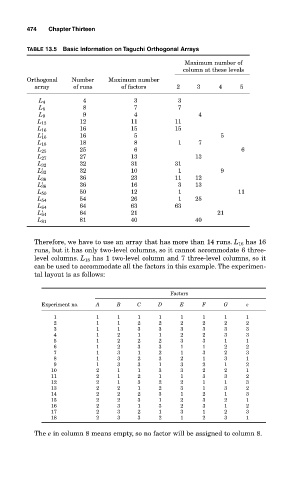Page 515 - Design for Six Sigma a Roadmap for Product Development
P. 515
474 Chapter Thirteen
TABLE 13.5 Basic Information on Taguchi Orthogonal Arrays
Maximum number of
column at these levels
Orthogonal Number Maximum number
array of runs of factors 2 3 4 5
L 4 4 3 3
L 8 8 7 7
L 9 9 4 4
L 12 12 11 11
L 16 16 15 15
L′ 16 16 5 5
L 18 18 8 1 7
L 25 25 6 6
L 27 27 13 13
L 32 32 31 31
L′ 32 32 10 1 9
L 36 36 23 11 12
L′ 36 36 16 3 13
L 50 50 12 1 11
L 54 54 26 1 25
L 64 64 63 63
L′ 64 64 21 21
L 81 81 40 40
Therefore, we have to use an array that has more than 14 runs. L 16 has 16
runs, but it has only two-level columns, so it cannot accommodate 6 three-
level columns. L 18 has 1 two-level column and 7 three-level columns, so it
can be used to accommodate all the factors in this example. The experimen-
tal layout is as follows:
Factors
Experiment no. A B C D E F G e
1 1 1 1 1 1 1 1 1
2 1 1 2 2 2 2 2 2
3 1 1 3 3 3 3 3 3
4 1 2 1 1 2 2 3 3
5 1 2 2 2 3 3 1 1
6 1 2 3 3 1 1 2 2
7 1 3 1 2 1 3 2 3
8 1 3 2 3 2 1 3 1
9 1 3 3 1 3 2 1 2
10 2 1 1 3 3 2 2 1
11 2 1 2 1 1 3 3 2
12 2 1 3 2 2 1 1 3
13 2 2 1 2 3 1 3 2
14 2 2 2 3 1 2 1 3
15 2 2 3 1 2 3 2 1
16 2 3 1 3 2 3 1 2
17 2 3 2 1 3 1 2 3
18 2 3 3 2 1 2 3 1
The e in column 8 means empty, so no factor will be assigned to column 8.

